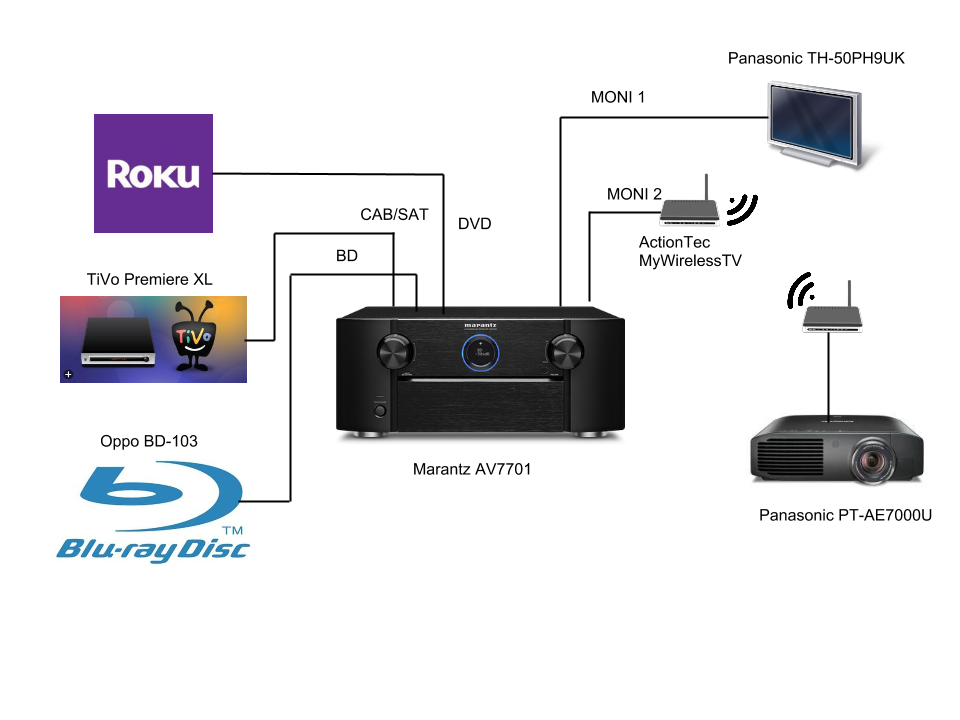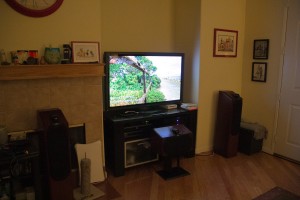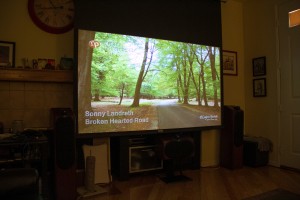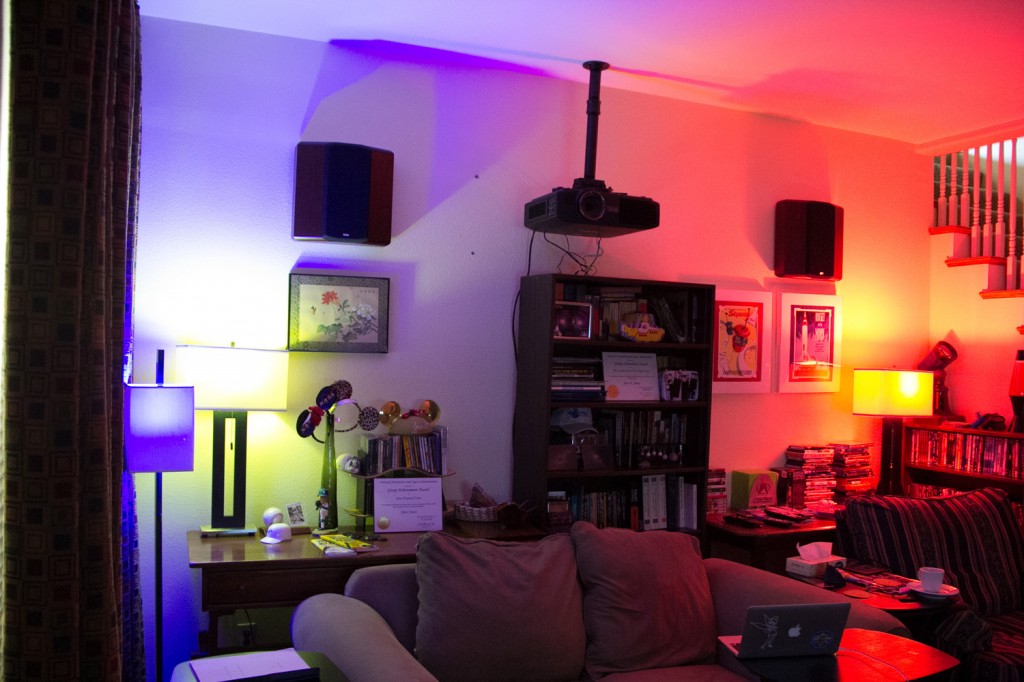First I’ll mention that the AV preamp I started out with, a Marantz 7005 purchased as B-stock from Outlaw Audio, turned out to be hopeless. It would never successfully handshake video output to either of my displays, even with no sources connected. Sometimes on a hard reboot, it would send some video, then fail within a minute or two. After discussing the problem with Marantz and Outlaw technicians, they honored my return request and took the receiver back. Kudos to both.
I replaced the 7005 with a new 7701 purchased from Amazon. It arrived right on time in two days using Amazon Prime shipping. One advantage for the 7701 is a second monitor output for the main zone.
This diagram shows my original plan for hooking up my home theater:
My first effort was with an IOGEAR Wireless HD Kit (GW3DHDKIT). My kit turned out to be dead on arrival: the receiver and transmitter would never sync, at any distance from each other. That kit went back to Amazon for a refund.
I replaced it with an ActionTec MyWirelessTV. This kit gave the appearance of being much more reliable. We actually watched a movie using this system, by connecting the Blu-ray player directly to the MyWirelessTV transmitter.
But it never worked reliably when routed through the AVR: If I changed sources or cycled through different configurations, it would all fall apart. Indeed there were periods when the transmitter would completely crash and do a reboot. It frequently caused my Roku box to crash completely as well, requiring a power cycle to reset it.
My first attempt to calm the system was to insert an HDMI splitter. I fed MONI 1 from the receiver to the splitter, and fed its two outputs to the plasma and the MyWirelessTV transmitter. This was no better.
I acquired a Gefen HDMI Detective on a recommendation from my friend William Phelps. This seemed to be promising: I could use the “detective” to present a stable EDID to the receiver. My study of HDMI technology seemed to support my theory that the constantly changing state of the wireless kit was making the whole system unstable.
Then I had a revelation. I noticed that my front door was not flush with the floor of the living room.
There appeared to be room to run an HDMI cable from the front of my room to the back unobtrusively, without ripping the walls. I guessed at the distance and ordered a 35-foot HDMI cable from Amazon (thanks again Amazon Prime free two-day shipping). Even if it didn’t work out, it would be enough to replace the wireless link for testing.
I have a perfectly good cable conduit from my AV cabinet to my projector. Why not just use that? When I first built the system, my electrician put 1-1/2-inch conduit in the wall from my A/V nook, up two stories to the attic then down from the attic two stories through the center of the house to my projector mount. In that conduit my installer ran three coax lines for component video, power cable, one cat-5 wire for S-video (remember that?) and one cat-5 for a screen trigger relay. (The conduit is packed tight!) The whole path is about a 75-foot run! For HDMI, that means using some kind of extender, either with two cat-5 cables or a fiber link. I had hoped to cheat with a wireless link. I’m continuing to use the power wire and screen trigger, but may not ever go to the effort of pulling out the unused video cabling.
I unwrapped my new 35-foot cable and ran it from the projector to the AV cabinet. It turned out to be the perfect length. It rests neatly below the front door. I haven’t yet secured it there, but for the moment it’s staying nestled.
I ripped out the wireless HD kit, and plugged my new cable into the projector and the splitter. My scientific impulse is to change only one factor at a time and test that, but I defied that impulse this time and decided to rip the splitter out of the system as well. I routed the cable to MONI 2 on the Marantz, and went for broke.
To my surprise and delight, every video source worked perfectly with both screens. The Roku didn’t crash. Configuration changes were completely smooth.
I configured the Blu-ray player to send 1080p video to the projector and the picture was beautiful. I even fed it some 3D video from a Lion King disc. I don’t yet have 3D glasses, but I could see that the picture was going to be perfect.
I set up the Marantz Audyssey calibration microphone and calibrated the receiver to my room. I put on the Muppets movie from 2011 and enjoyed it in gorgeous 1080p with great audio.
To complete the upgrade, I installed a set of Philips Hue wireless LED bulbs in our living room lamps. My new Logitech Harmony Ultimate remote control is able to control the bulbs. So now I have programmed lighting for each A/V activity: bright for radio, partial bright for the plasma screen (with one bulb that has a reflection in the screen for me turned off), and fade to dark for the projector.
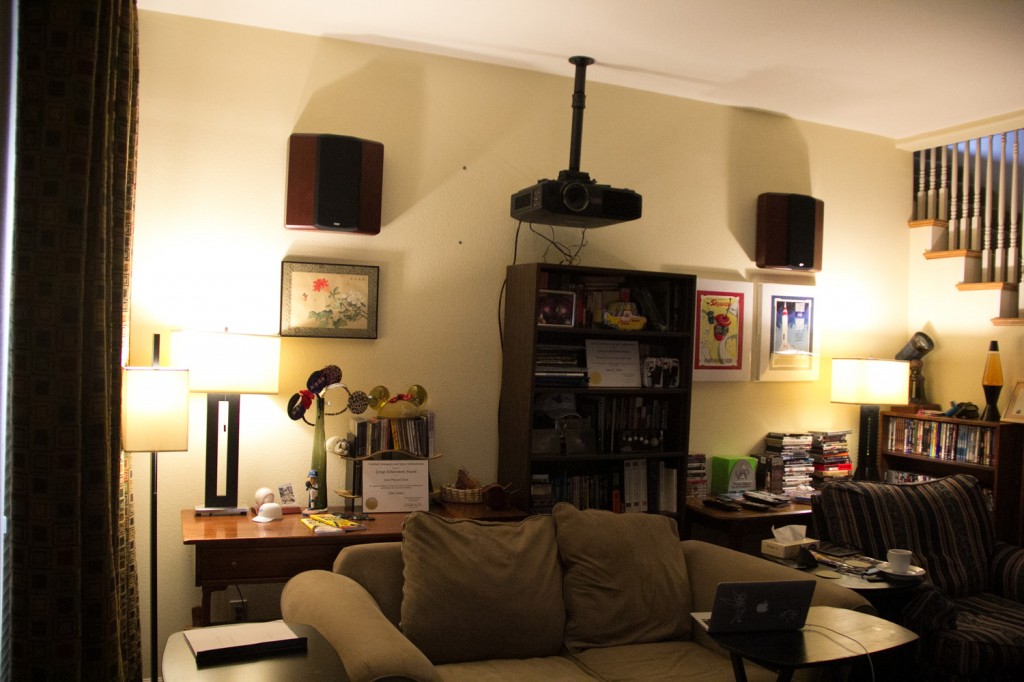
The Philips Hue bulbs in a more natural low color temperature lighting, also showing the projector ceiling mount and surround speakers.
The final irony is that the Philips Hue bulbs are the single most impressive part of the whole upgrade. Still, the whole package looks and sounds great, and is dead simple to operate. Mission accomplished.

